The Beginning
On Feb. 9, 1964, music in America changed forever when the Beatles appeared on the Ed Sullivan Show.
by Glenn Gass
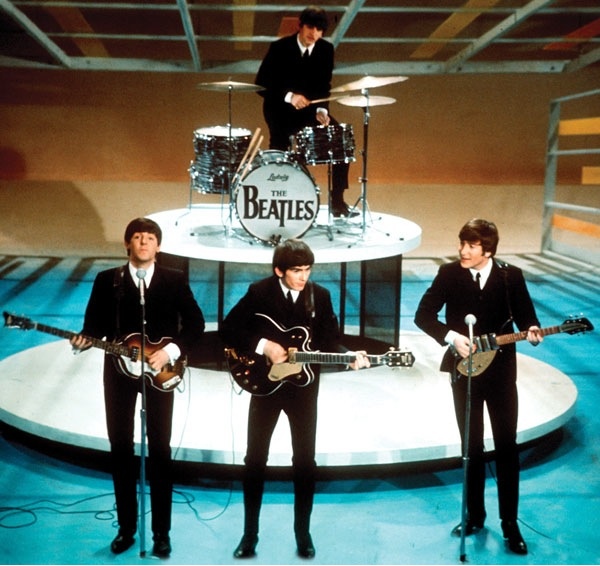
The Beatles on the Ed Sullivan Show … 50 years ago. That milestone is hard to grasp for those of us who remember it — not exactly like yesterday, but certainly not like a half-century ago.
For those too young to remember, it’s probably hard to even imagine a time when an entire generation watched the same live television show and was changed by the same thing at the same time. No repeat broadcasts later in the week, no DVR, no Facebook, no YouTube … one big moment, and you didn’t dare miss it.
You would likely have seen the Beatles on the Ed Sullivan Show even if you didn’t know it was coming (though we all did).
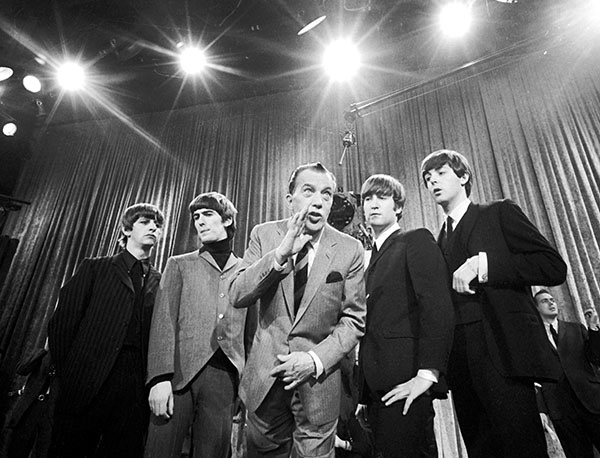
More than 73 million television viewers watched the Beatles’ first appearance on the Ed Sullivan Show in 1964, the largest TV audience ever recorded by Nielson.
Sullivan and the Beatles
The Beatles appeared on the Ed Sullivan Show four times. They appeared on three consecutive Sundays in February 1964 and again in August 1965:
•On Feb. 9, the band performed “All My Loving,” “Till There Was You,” “She Loves You,” “I Saw Her Standing There” and “I Want to Hold Your Hand.”
•On Feb. 16, the show was broadcast from Miami Beach. The Beatles opened with “She Loves You,” “This Boy” and “All My Loving.” The show closed with “I Saw Her Standing There,” “From Me to You” and “I Want to Hold Your Hand.”
•The Beatles’ Feb. 23 appearance was on tape (from two weeks earlier before the live television show). They performed three songs: “Twist and Shout,” “Please Please Me” and “I Want to Hold Your Hand.”
•On Aug. 14, 1965, the Beatles performed “I Feel Fine,” “I’m Down,” “Act Naturally,” “Ticket to Ride,” “Yesterday” and “Help!”
In subsequent years, the Beatles gave Sullivan exclusive clips of the band performing songs, including “Paperback Writer,” “Rain,” “Penny Lane” and “Strawberry Fields Forever.”

Star Maker
The Ed Sullivan Show was a variety show that aired on CBS from 1948 to 1971. Although the show featured acts of all kinds, it is credited with airing breakthrough performances by musical legends before they were stars. Most notable are Elvis Presley, the Beatles, the Supremes, the Rolling Stones, the Beach Boys, the Jackson 5, Janis Joplin and The Doors.

Elvis Presley on the Ed Sullivan Show Sept. 9, 1956
Sunday Nights with Ed Sullivan
The Ed Sullivan Show was a Sunday night family ritual long before the Beatles came along, a vaudeville-style variety show featuring comedy acts, classical pianists, trapeze artists, exotic dancers, singers, movie stars, magicians, musical theater troupes (including, immediately following the Beatles, future Monkee Davy Jones and the cast of “Oliver” and Topo Gigio, the talking mouse — you had to be there).
Sullivan introduced each act with a flat deadpan delivery more in keeping with a high-school talent show than a major television network. In his attempt to have something for everyone, the range of acts he booked was ludicrously varied. Luckily for us, he included acts for “the youngsters,” as Sullivan put it, and the Beatles could not have hoped for a bigger boost to their American ambitions. The Ed Sullivan Show was the most important show on television for an aspiring act of any kind. The exposure it offered could ignite a career and, as with the Beatles, turn a performance into a cultural event, thanks to the sheer enormity of the audience.
Sullivan was always on the prowl for talent, and we were always watching to see what gems he might come up with between the dancing elephants and Anacin commercials.
In late 1963 when Sullivan signed the group, still completely unknown in America, to an unprecedented three-week run the following February, he forced Capitol Records to end a year of foot-dragging in America and get behind the Beatles’ next single, “I Want To Hold Your Hand.” The record went to No. 1 in January 1964, just in time to whip up excitement for the Sullivan appearance.
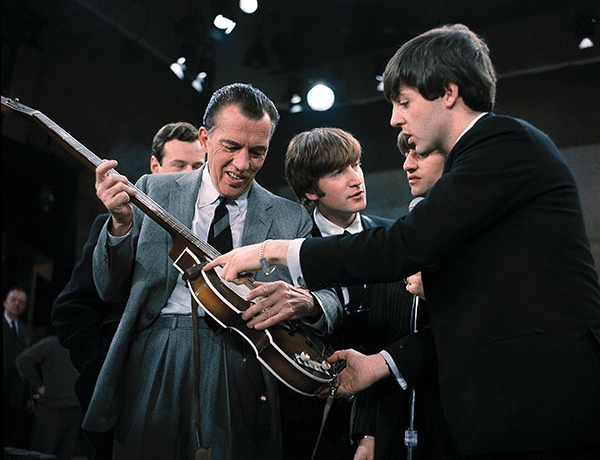
All four Beatles’ appearances on the Ed Sullivan Show were in black and white. The show switched to color the week after the band’s last appearance.
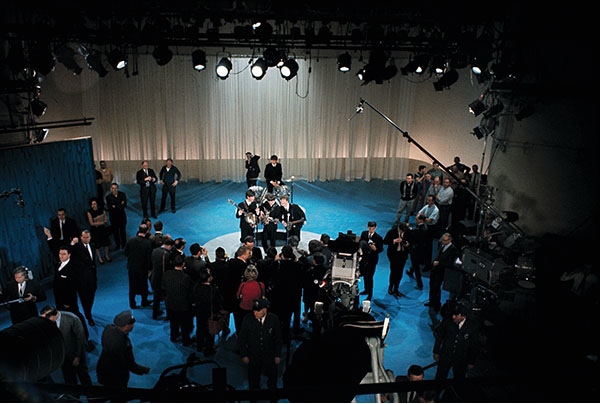
Photographers surround the Fab Four as they rehearse at CBS’ Studio 50.
Nothing Else Mattered
And what excitement. That name! That hair! Those accents! Strange as it now seems, the music was not really much of an issue, beyond the climactic head-and-hair-shaking “woos” (cue screaming girls) and Paul’s octave leap on the word “hand,” which jumped out like a jack-in-the-box no longer able to contain its excitement. No one considered the music to have any real depth or, Lord knows, lasting value.
All around the country kids sat awkwardly by their parents that Sunday night watching their world change while the adults rolled their eyes and made derisive comments. (“How long do you think they will last?”) Yes, there was a time when parents hated the Beatles, or were bemused at best, as if the Beatles were just a long-haired sideshow routine.
Our parents’ cluelessness only made the Beatles more special, more wholly ours. The next day at school all anyone had to say was “Well?” and the conversation immediately turned to the Beatles: What did you think? Which one was which? Was that hair real? Which one was the leader? Could you understand a word they said? Liverpool?
Nothing but the Beatles seemed to matter or even exist. It was a new world, and we knew it — not in retrospect, but right then. The world had shifted on its axis, and our time had begun. A New York fan held up a sign reading, “Elvis is dead! Long Live the Beatles!” And it was true: The ’50s and rock’s first era were over. The king was dead. Long live the new kings, the Beatles.
The Beatles’ appearance on the Ed Sullivan Show on Feb. 9, 1964 was one of the great television moments of all time, a one-two punch of aural and visual exhilaration that catapulted the Beatles directly into orbit. It also marked the true arrival of the ’60s, as the baby boomers rumbled to life and began the transformation into the Woodstock Nation. That journey was driven in no small part by our emulation of the Beatles, beginning with hairstyles and ending with a nonconformist worldview in complete opposition to the values of our parents, our government and most other symbols of authority.
The Beatles, on that Sunday night, were the first thing that truly united us — the first thing that gave “us” meaning — and they remained a constant through the ever-changing ’60s, the beating heart of the counter-culture. They were like everyone’s incredibly cool older brothers, telling us not to worry about mom and dad and bringing us to each new experience, each new reality, with the reassuring message that there was room enough for all. It was thrilling, joyful and oddly comforting: You knew the Beatles would never let you down or lead you astray, and they never did.
The timing of the Beatles’ invasion of America couldn’t have been better, between the enduring doldrums of the Kennedy assassination and a musical culture stuck in reverse. It seemed like only an invasion of aliens from outer space could possibly make things exciting again.
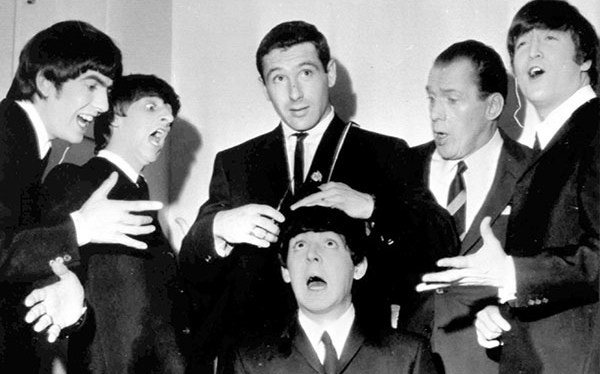
Speed skater Terry McDermott, a barber by trade, pretends to lop off Paul’s locks as his bandmates and Sullivan look on in mock horror.
A New Kind of Rock ‘n’ Roll
And they came! The Beatles, with that impossibly long hair (Were they wigs? Could male hair actually grow that long?) and those indecipherable accents, seemed like a new breed of young people full of life and energy. The music they made sounded sleek, new and immediately right. It was rock ’n’ roll but in a brand-new guise.
And they were a group without a leader, a group of equals. It seemed strange indeed, as we struggled to figure out which one to watch, before we realized they were four parts of a whole (the “four-headed monster,” as Mick Jagger put it).
The lead guitar player was elevated to a starring role, standing in the middle, but he didn’t have a microphone, forcing him to roam over to join one of the other singers to add his harmonies. It was a true joy to watch George on “All My Loving,” the first song they played on the show, as he joined John for harmony “oohs” then played a wonderfully concise guitar solo before joining Paul to sing lead harmonies on the verse — the ultimate swingman on the ultimate team.
Meanwhile, the two main singers were on opposite sides, beautifully symmetrical thanks to Paul’s left-handed bass playing. And the drummer — Ringo! At least we knew which one he was, thanks to his name and nose. Yes, he was in the back, as usual for drummers, but on a riser and always visible.
They looked stunning, perfect, like a whole world compressed into all that mattered. “I Want To Hold Your Hand” was already a No. 1 hit, but seeing the Beatles fired our collective imaginations in a way that a mere record never could (until Sgt. Pepper’s Lonely Hearts Club Band, anyway, three insanely long years later).
They seemed to love singing together and seemed to love each other in a joyous, natural way without a trace of show business phoniness. They were the very image of youth and fun, and we all desperately wanted to be a part of it. We ditched our acoustic folk guitars and formed bands if we could. If not, we just yanked on our hair to get it to grow faster and strummed badminton racquets as we sang along to those amazing records.
Sullivan’s set added to the image of a perfect, seamless whole, surrounding the Beatles with a circle of huge arrows pointing inward as if ready to set off a nuclear implosion. Something even bigger detonated that February night. We couldn’t have imagined the Beatles in our wildest dreams, and then we took one look and shouted a collective, “Yeah, yeah, yeah!”.
Glenn Gass is a professor at Indiana University, where he teaches courses that he developed on the history of rock music, including a course on the Beatles that he has offered since 1982, the longest-running course on the Beatles in existence. His favorite Beatles song is whichever one he’s listening to at the moment, although if he had to pick, it would be “In My Life.”